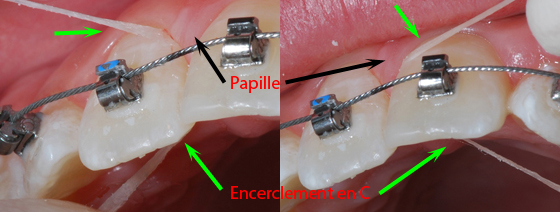Oral hygiene
How can I keep a good dental health during my orthodontic treatment?
A good dental health and everything that supports the teeth (gum, bone, ligaments) contributes to the success of the results aimed by your orthodontic treatment. Your cooperation is essential at this level.
If you use the techniques shown and respect the recommended frequency for the hygiene of your mouth and teeth, you will help your body by making it possible for it to put its energy on the movements imposed by orthodontics rather than fight diseases that represent tooth decay, gingivitis (gingival inflammation) and periodontitis (inflammation of the bone, gums and periodontal ligament).
Dental floss:
Frequency: Once per day. We recommend in the evening after dinner or before going to bed.
• Insert the floss into the threader and make a knot to hold it into place.
• Slip the threader between 2 brackets, under the wire.
• Slip the floss gently under the gum from top to bottom,
by forming the letter “C” around the tooth (green arrows).
Slip the floss under the gingival papilla (black arrow) and pull it upward to free up the interdental papilla. Switch sides and slip again under the gum. Pull upward. Unthread.
• Repeat between each adjacent tooth up to the back. Be systematic, choose your sequence and do both arches from front to back.
Brushing:
Frequency: morning, midday, evening, after each meal and before going to bed.
• Use a soft-bristled toothbrush.
• First brush every tooth by placing the toothbrush bristles inclined toward the gum and, with a slight pressure, go down or up toward the teeth (depending if you brush your upper or lower teeth).
• You now have to brush the braces.
Place the brush at an angle above the appliances in a way to make the bristles point toward the brackets.
Tell yourself that you must clean all around the brackets and under the wire. With circular movements, remove dental plaque and pieces of food.
Then turn the brush around to clean underneath the braces.
• Use this technique properly on the anterior and posterior teeth, on the upper as well as the lower teeth.
• Do not forget to clean the teeth on the lingual and palatal sides, as well as the top of the teeth (the chewing surfaces).
Repeat the same movements on the upper teeth.
• A good brushing should take at least 2 minutes.
Interproximal toothbrush:
Frequency: at least once per day, generally in the evening. However, since it is easy to use and it is always possible to have one with you, the Proxabrush interproximal toothbrush can help out after a meal taken outside of the house when you don’t have a normal toothbrush at hand.
• Remove the cap and put it at the other end of the brush to form a slightly longer handle.
• Bend the end where the bristles are located.
• Clean under the wire, between each bracket, once per day or more if necessary.
Tips not to forget areas to clean:
— From one cleaning to another, choose a sequence that will always stay the same. For example, always start with the posterior upper right teeth, and head to the left completely. Then, brush the posterior lower right teeth to end with the lower left molars. You will thus avoid forgetting some areas that deserve as much attention as the others. Use the same sequence for dental floss.
What will happen if I don’t put in the necessary effort to keep my teeth clean?
Any food that is ingested leaves traces behind. Our mouth contains a large number of bacteria and these bacteria form what we call bacterial plaque or dental plaque.
As in an amusement park, bacteria left in place will take great pleasure in acting in their own good way. Bacterial plaque sticks everywhere and the brackets, bands, wires and other orthodontic appliances are also available places to fix themselves to and multiply.
Bacteria then feed on residues left in contact with the surfaces of teeth and brackets. Bacteria eat! And if they eat, they produce and evacuate waste products. These waste products are acids that dissolve and soften the tooth enamel and cause gum irritation, which causes gum inflammation.
Enamel softening can be seen through tooth bleaching. It is a white spot (red arrows) and it is the beginning of a surface cavity which can spread deeper. Once the appliances are removed, these discolorations, although they can be decreased by fluoride treatments, are generally permanent.
Gingival inflammation that causes the gum to swell (green arrows) is called gingivitis and the first sign of inflammation is bleeding gums. We have to remember that if gums bleed while brushing, it means that they were not brushed properly the previous time.
Swollen gum will sometimes cover, in part, one or several brackets.
For swollen gum, after the braces are removed, if hygiene gets back to normal, its appearance will improve.
However, in some cases, a surgical procedure (gingivectomy) must be done to remove the excess that makes the teeth look a lot shorter than they really are.









Ask a question or leave a comment (0)